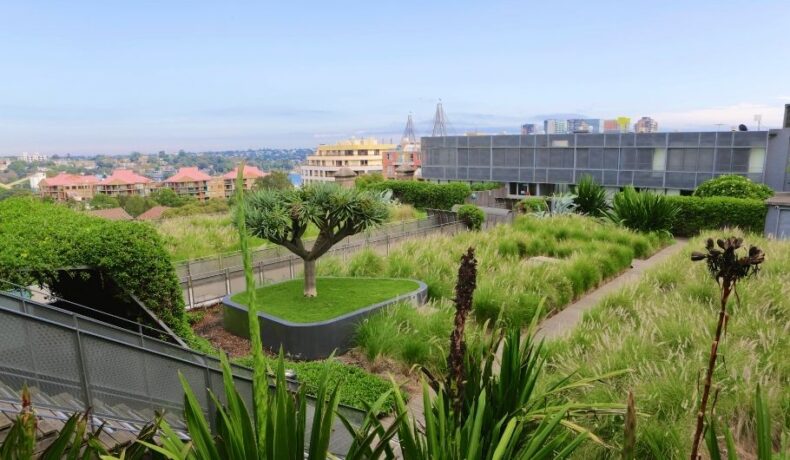Planting on roofs and walls may have begun in Europe, but the practice is becoming increasingly popular worldwide. You can find these green roofs in urban areas around the world, helping to reduce the negative impacts of urbanization while aiding us in our efforts to re-introduce nature back into our “concrete jungles”.
It doesn’t just stop there though. People, wildlife, our cities, the environment at large – green roofs have a far-reaching, positive impact.
But to truly appreciate the impact of this green tech concept, you need to be aware of and understand the plethora of advantages that come with it.
So if greening up your home, your city, and looking after the planet is of interest to you, read on.
Table of Contents
What is a Green Roof?
Green roofs – also known as eco-roofs, living roofs, or vegetated/vegetative roofs –are systems involving the use of various types of vegetation on top of buildings.
Green roofs have the following layers:
- Vegetation
- Growing medium (substrate)
- Filter layer
- Drainage layer
- Protection matt
- Waterproof membrane
- Insulation layer
- Vapor control layer
- Roofing material

Image source: All American Construction
Additionally, green roof systems need to be applied over a layer with a minimum slope of 2%. This helps to drain any excess rainwater along the roof.
Cost-wise, you’ll find that green roofs are pricier than their conventional roof cousins. This is because they require extra maintenance.
The type of vegetation present on a green roof will largely determine the level of maintenance required, including irrigation needs.
What Are The Different Types Of Green Roofing?
There are 2 main types of Green Roofing and 1 sub-type. They are:
- Intensive
- Extensive
- Semi-Intensive
The depth of the planting medium and maintenance requirements help to determine the type of green roof.
Intensive
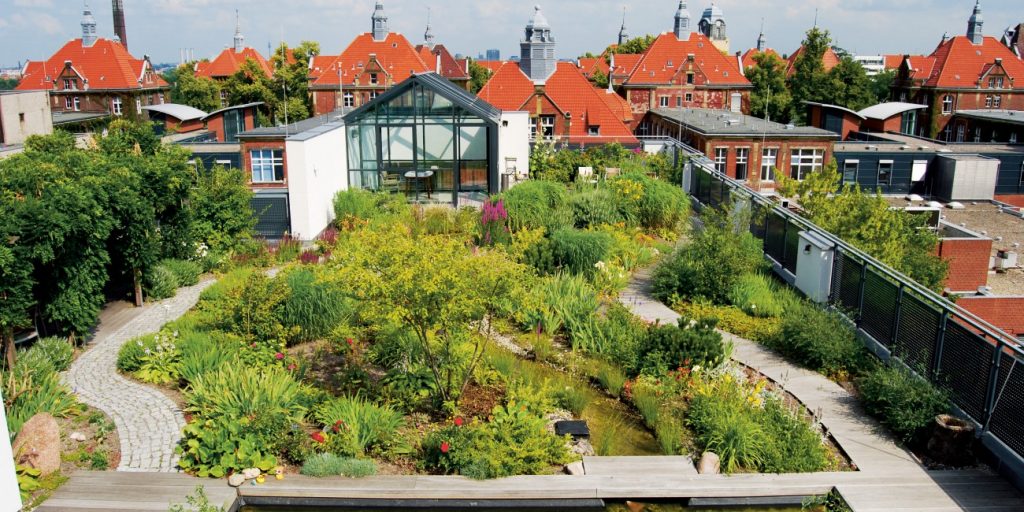
Image source: Urban Green-Blue Grids
Intensive green roofs get their name from the fact that they require a high level of maintenance. This is because they are designed to function more like a conventional terrestrial garden where there are a variety of plants that require individual attention.
These roofs have a thicker substrate layer (over 15–40 cm), allowing the integration of a wide variety of plants – shrubs, bushes, and small trees.
Extensive
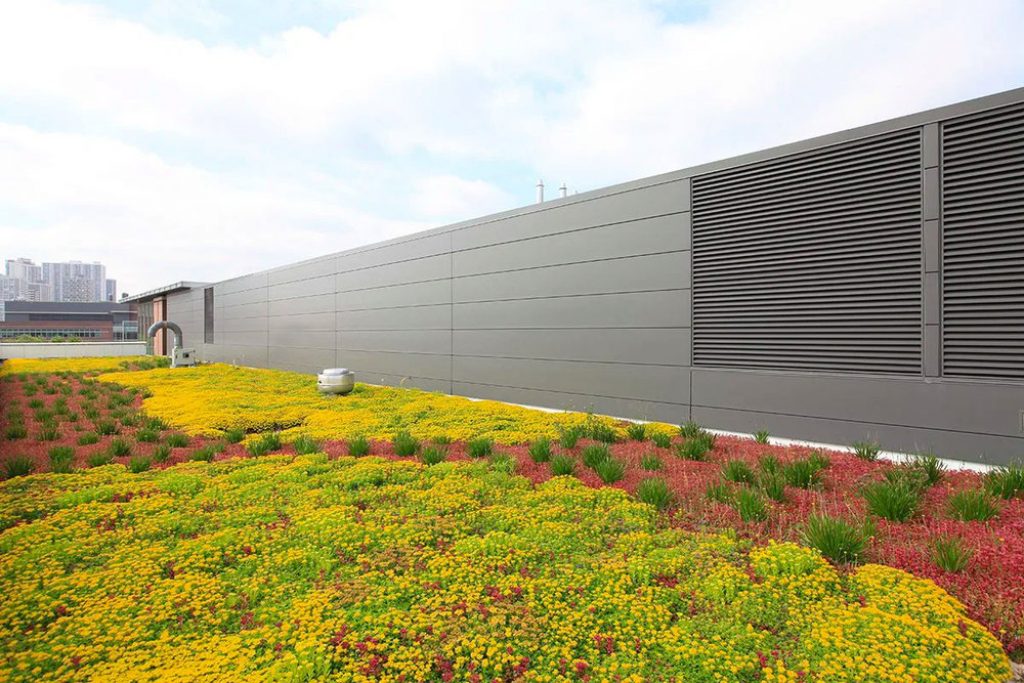
Image source: Bent Architecture
On the other hand, extensive green roofs are lightweight green roof systems that require less maintenance.
These systems can be installed on existing, flat, or sloped roofs up to 30°, improving the aesthetics of non-accessible roofs.
Due to their thickness (6–20 cm), extensive systems have limitations on plants variety. Several studies indicate the use of succulent plants as viable options.
However, other vegetation types can also be used in extensive systems, such as mosses, grasses, wildflowers, and grasses.
Semi-Intensive

Image source: Olympia Green Roofs
Semi-intensive or simple intensive green roofs have intermediate characteristics. One such characteristic is a thicker substrate (12–25 cm) than extensive solutions. However, they require less in the way of irrigation and maintenance in comparison to intensive green roofs.
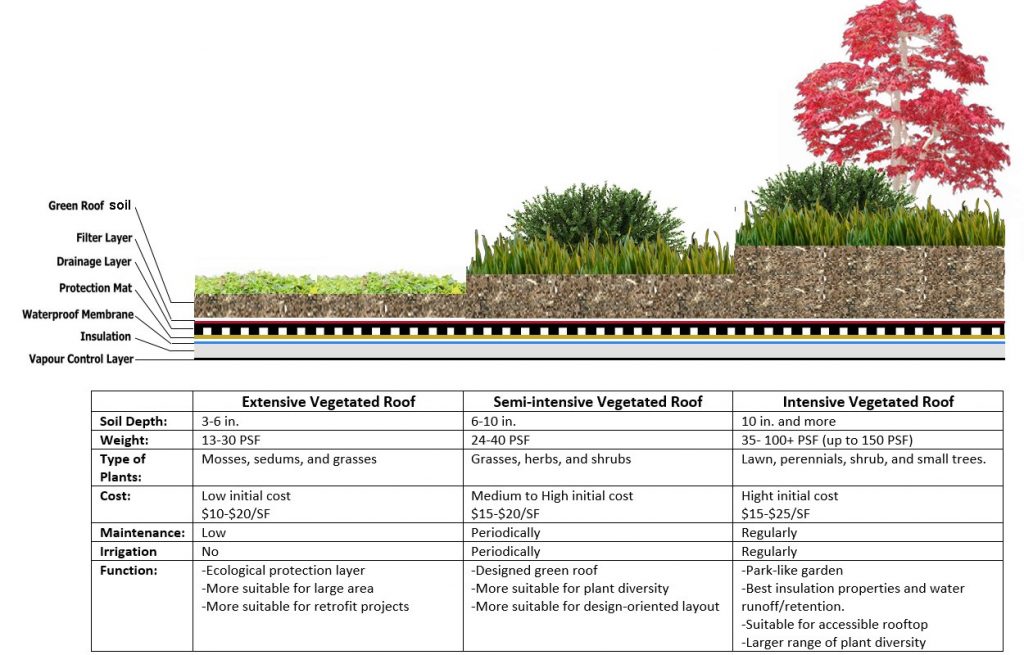
Green Roof Technology Systems
Green roof technology falls into the following categories:
- Complete
- Modular
- Precultivated Vegetation Blankets
Complete System

Complete systems provide the most flexibility in terms of the type and nature of growing medium and drainage, and protection layers that can be used.
These have a direct impact in terms of the type of vegetation that the green roof can support. They also generally contribute the greatest amount to the structural design load.
Modular System
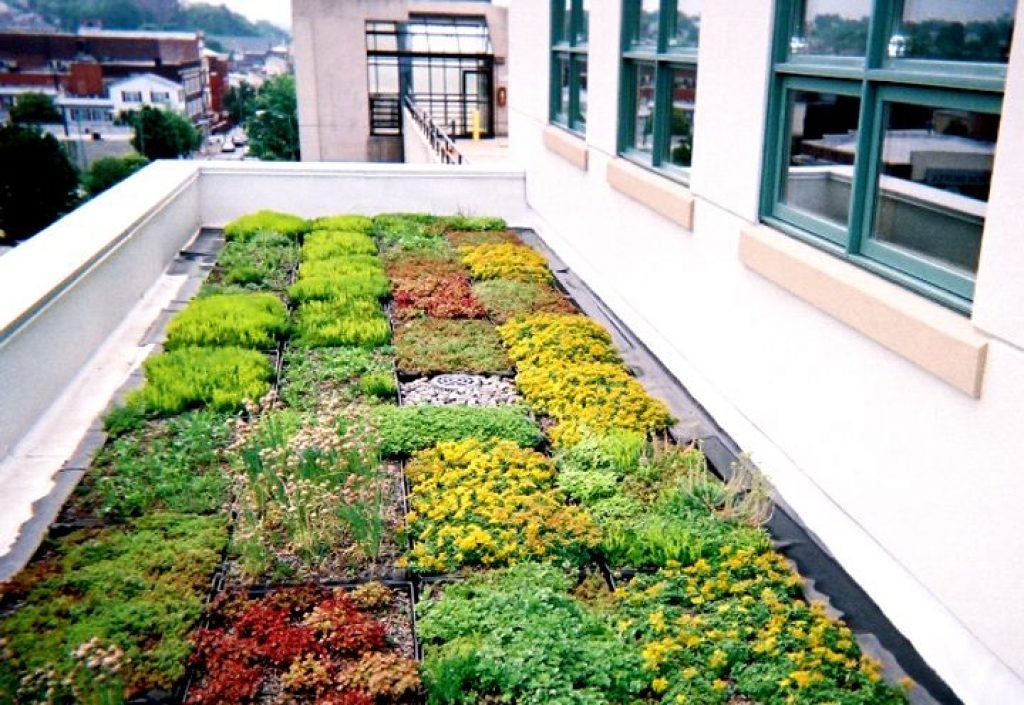
Image source: Green Roofs
Modular systems are essentially trays of vegetation in a growing medium that are grown off
the site and simply placed on the roof to achieve complete coverage.
Precultivated Vegetation Blankets
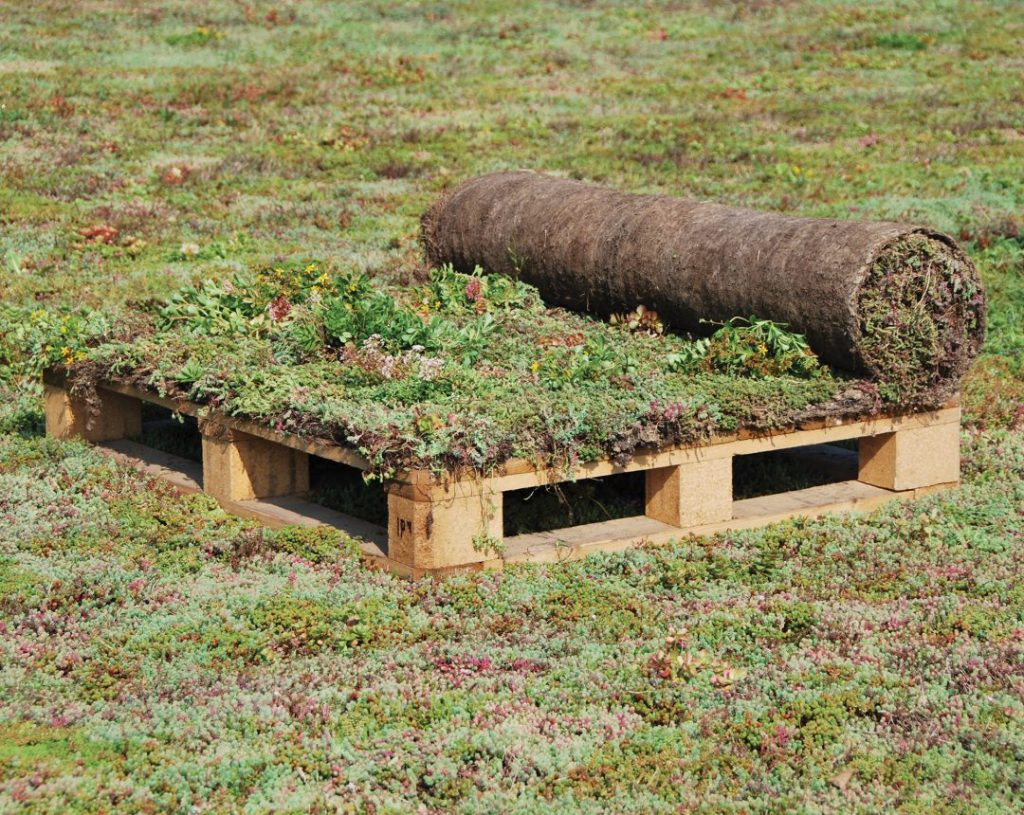
Image source: Stresne Substraty
This system consists of a growing medium and plants that are rolled onto the existing roofing system with drainage mats and root barriers as required.
Pros & Cons of Green Roofs
Like with anything else, the green roof system comes with its own pros and cons.
Pros Of Green Roofs
The known benefits of green roofs fall under three main categories:
- Storm-water management
- Energy Conservation
- Urban Habitat Provision
For you to truly understand the positive impact that these roofs can have, we’re going to expand on each of these categories a little more while discussing further benefits.
Storm-Water Management
Traditionally, urban areas are characterized by surfaces that are hard and non-porous. Because these surfaces aren’t able to effectively absorb water, they contribute to heavy runoff. In doing so, they overburden existing storm-water infrastructure.
This spells bad news for our lakes and rivers. Why? Three guesses where the resulting overflow or sewage lands up…
In addition to exacerbating instances of flooding and erosion, this urban runoff is also high in pollutants such as petroleum residues and pesticides, both of which are extremely harmful to wildlife habitats and our drinking supply areas.
So what about conventional storm-water management techniques like storage reservoirs, sand filters, and ponds?
While these options are effective, they are also very surface-area intensive methods. This makes them difficult to implement in very dense areas.
This is where green roofs come into play. These roofs make use of existing roof space while preventing runoff.
To put this into perspective, green roofs can reduce annual totally building runoff by as much as 60% to 79%. Moreover, estimates based on 10% green-roof coverage suggest that they can reduce overall regional runoff by about 2.7%
Thermal Benefits
Green roofs have proven themselves to be an attractive option for people looking to save on building-related energy costs.
How do they do this? By reducing energy demand through improved thermal performance through shading, better insulation, and higher thermal mass of the roof system.
Additionally, the growth medium provides added insulation to the roof, and the water content increases the thermal inertia of the structure.
As an example, this study from Greece shows that green roofs have the ability to reduce the energy used for cooling by between 2% – 48%. This figure depends on the area covered by the roof.
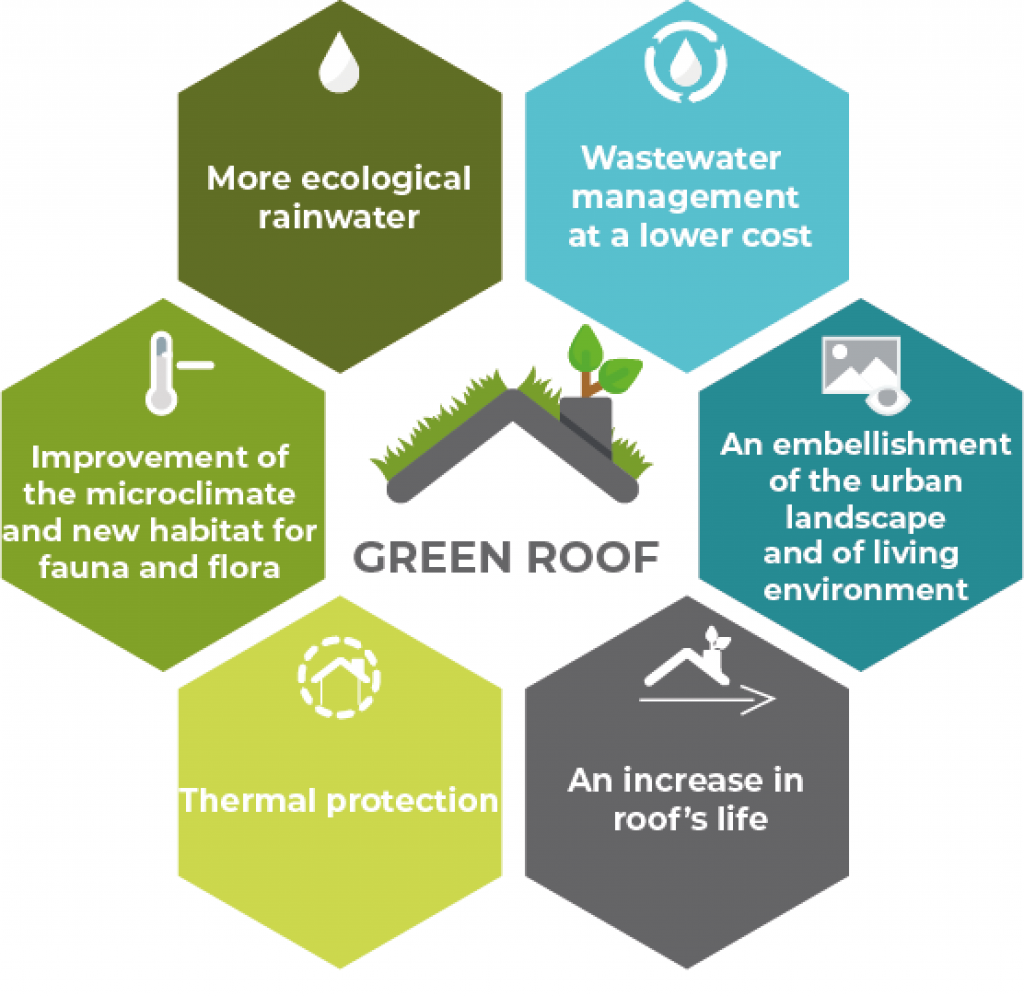
Image source: Rio On Watch
Reducing Air Pollution
Urban areas are often rife with air pollution – general air quality is poor and both people and the environment suffer as a result.
Generally speaking, plants have the ability to reduce air pollution by means of consuming gaseous pollutants or indirectly modifying microclimates.
Taking the above into account, it stands to reason that green roofs are capable of performing the same function.
Not entirely convinced? Well how about this – this article by Rowe notes that just one square meter of green roofing could offset the annual particulate matter emissions of one car – incredible!
Psychological Benefits
The benefits of green roofing extend way beyond the physical realm. That may sound a little airy-fairy to some of you, but hear us out.
How many of you out there can honestly say you don’t find plants pleasing to look at?
Better yet, how often do you find yourself admiring the utterly boring, flat rooftops that populate urban areas?
Chances are, the answers to those questions are “none” and “not very often”.
Well, green roofs have the ability to enhance the aesthetic appeal of any building that they are added to. Because of this, you’ll find that the more greenery there is in-an-around buildings, and a city in general, the better your state of mind.
An article by Hartig et al backs this up by noting that, even when green roofs are only accessible as visual relief, they improve human health through relaxation and restoration.
Local Habitat Conservation
Humans aren’t the only ones that matter, our planet’s wildlife is just as important as we are. So it’s wonderful to know that the bi-product of green roofs is an improved level of local habitat conservation.
You’ll find that these roofs are home to a variety of species such as ants, beetles, bees, spiders, and other bugs.
Moreover, green roofs are also used by nesting birds and local avian communities. As such, national conservation organizations around the world make a point of promoting green-roof habitats – particularly ones that maximize biodiversity.
Cons Of Green Roofs
While the pros of green roofs far outweigh the cons, the downsides are still worth noting.
After all, they do have some constraints, at least according to the public or policymakers.
Cost Implications
First and foremost is the cost of constructing a green roof. Sure, these roofs are seen as long-term investments but they do come with substantial upfront expenses.
You need to factor in the following costs:
- Installation
- Location
- Labour
- Equipment
- Vegetation
Added Maintenance
Plants require care to survive and thrive. Considering the fact that green roofs are made up of vegetation, it stands to reason that they’ll require the same level of TLC.
In fact, forget about the fact that it’s a roof at all, what you really need to view a green roof as is an extra garden. As such, you’ll need to water it, feed it, and de-weed it, just like any normal garden.
Some of you may enjoy the process of maintaining a green roof, while others may find it tedious.
Weight Bearing Issues
The components of a green roof carry with them additional weight. As such, the weight-bearing load of your roof is something that has to be taken into consideration.
When fully covered, a typical extensive roof with 3 to 4 inches of growing medium weighs 17 to 18 pounds per square foot, and a deeper intensive system can weigh 35 pounds or more per square foot.
If you don’t account for the additional weight, you can find yourself with a roof that has been structurally compromised.
How Much Do Green Roofs Cost?
Life-cycle costs (LCC) are typically divided into installation cost, operation and maintenance cost and disposal cost.
Installation Costs
The installation cost of green roofs considers the initial investment in the application of the system, including the cost of transportation, materials, and labor.
The below figure presents the installation cost of extensive, semi-intensive, and intensive green roofs respectively, by multiple from the following source.
The average installation costs vary significantly between countries and are as follows:
- Extensive green roofs – 99 €/m2 (112 USD/m2)
- Semi-intensive green roofs – 130 €/m2 (147 USD/m2)
- Intensive green roofs – 362 €/m2 (409 USD/m2)
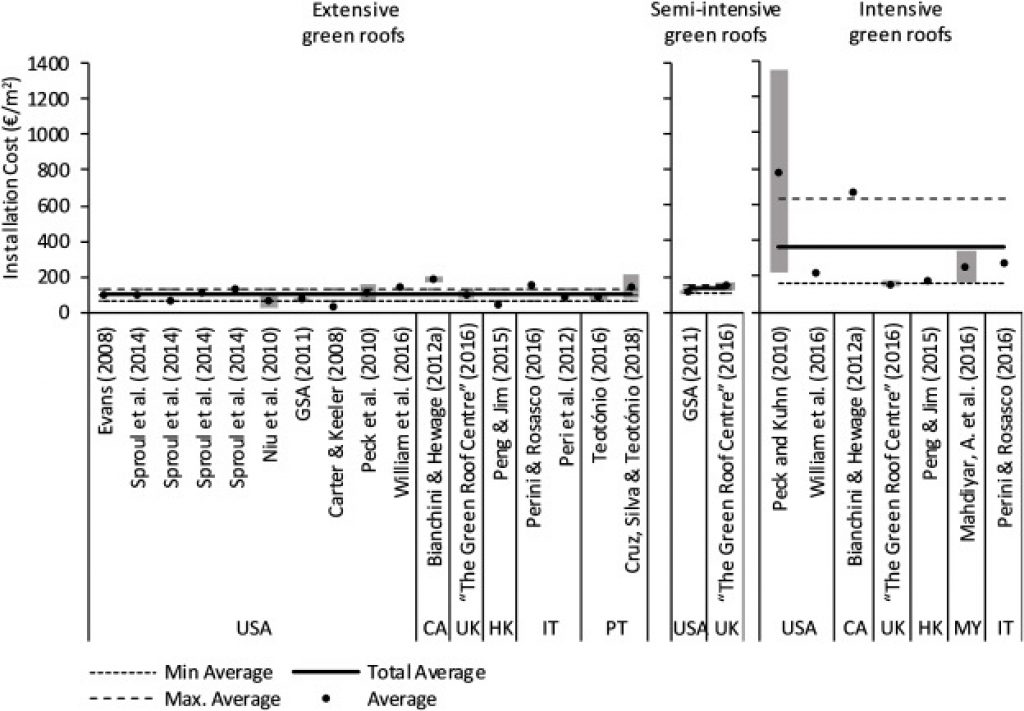
Operation & Maintenance Costs
It’s important that you understand how green roof maintenance is carried out.
Consider the following:
- Is your maintenance performed by you or by a 3rd party?
- What materials need to be replaced?
- How is the climate in your area?
- What plant species do you have?
- How much irrigation do you need to perform?
Although there is no data related to maintenance cost reduction over the years, usually extensive green roofs require less maintenance than intensive green roofs.
In the first years, green roofs usually have more irrigation needs and re-planting may be needed due to plant inadaptation.
The below figure shows the operation and maintenance costs of extensive, semi-intensive, and intensive green roofs obtained from the following source.
The average maintenance costs vary significantly from country to country and are as follows:
- Extensive green roof -4,28 €/m2/year (4,84 USD/m2/year)
- Semi-intensive green roof – 7,77 €/m2/year (8,78 USD/m2/year)
- Intensive green roof – 5,64 €/m2/year (6,37 USD/m2/year)
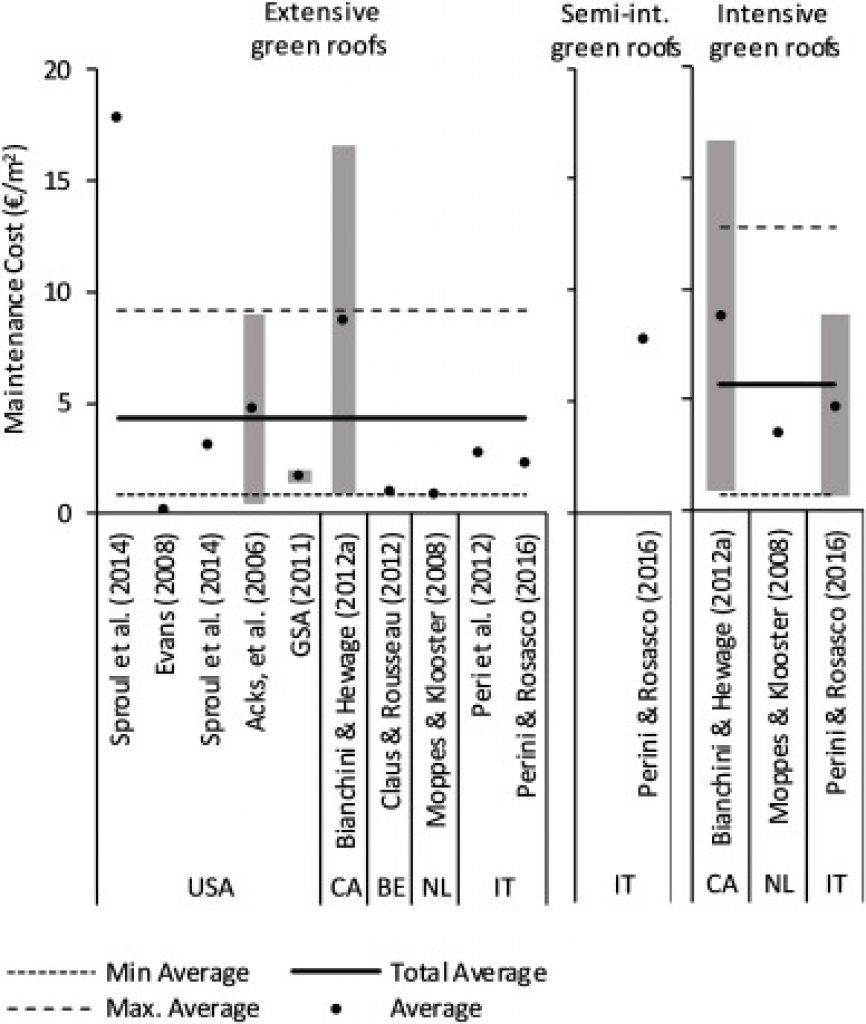
Disposal cost
Green roofs and green walls systems disposal costs normally include all system elements including the following:
- Removal of all plants, substrate, and support layers.
- Transport to landfills.
- Dump taxesSome studies take into consideration the
- Roof replacement.
- Recladding and renewal of the support surface.
The below figure presents the disposal cost of extensive and intensive green roofs obtained from the following source.
Here are the average disposal costs:
- Extensive green roof – 12 €/m2 (14 USD/m2)
- Intensive green roof – 26 €/m2 (29 USD/m2)

How Often Do Green Roofs Need To Be Replaced?
Green Roof Lifespan
The lifespan of green roofs depends on the maintenance, type of green roof, and weather conditions.
Taking into consideration four studies, whose results can be found here, it can be concluded that the lifespan of green roofs ranges from 40 – 55 years.
Green roofs have been around since the 1960s. This has provided us with enough time to take note of and monitor the longevity of these roofing systems.
In Germany (the birthplace of modern green roof systems) and other parts of Europe, green roofs have been known to last for 30 – 50 years.
In other words, if you already have a green roof system, or are looking to invest in one, don’t expect to replace it any time soon.
Green Roof Maintenance
Now that we’ve addressed the lifespan potential of a green roof, let’s take a look at the maintenance that these systems require. After all, the two go hand in hand.
Before we go any further, it must be noted that the type of maintenance activities required for a green roof will depend on the plantings and regional climate.
Watering
Your green roof will most likely require irrigation during its establishment period – unless your area is having plenty of rainfall at the time.
Additionally, you’ll need to make use of overhead watering immediately after installing plugs, seeds, or cuttings. Even green roofs with underground drip irrigation systems will need overhead watering until the roots have grown enough to reach the water from the driplines.
After your vegetation has become well established, your irrigation requirements will depend on the plant species chosen, as well as the water holding capacity of your growing medium and other components.
Weeding
You should inspect your roof and spot-weed it every 2-4 weeks during the growing season.
It’s important to remove weeds before they flower and set seeds to minimize future efforts.
According to the Green Grid Roof maintenance guide, in most climates, green roof weeding will require about 10 to 20 man-hours of weeding per year.
Plant Care
There are two primary components that will make up your plant care maintenance regime – fertilizing and trimming.
You should fertilize annually (in spring) for the first 3-5 after your installation. Following that, do it on a reduced – need to – basis pending plant performance.
In terms of trimming, you’ll want to trim dried vegetation that’ll negatively affect your spring growth. Do this annually, prior to spring growth flush.
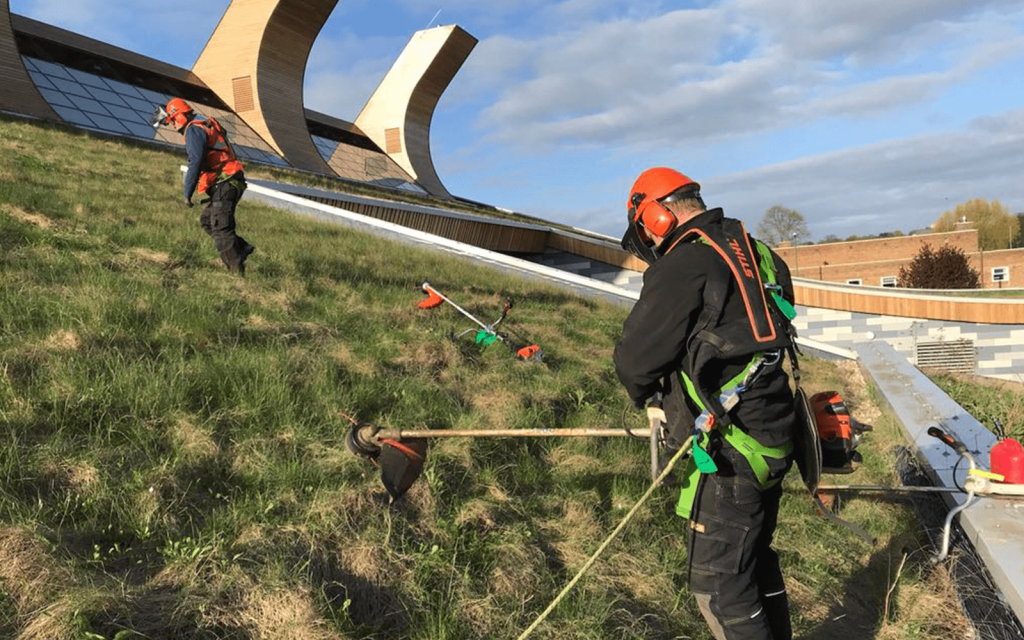
Image source: ICB Projects
Roof Membrane
This maintenance manual for green roofs notes that the waterproofing roof membrane is the most vital aspect of your green roof’s longevity and success.
As such, there are areas of your roof that’ll require regular inspections, at least three times per year.
These include all joints, borders, or other features penetrating your roof, such as vertical walls, roof vent pipes, outlets, air conditioning units, and perimeter areas.
Drainage Inspection
Regularly inspecting your drains – approximately three times per year – is essential to maintaining a healthy green roof system.
Insufficient drainage in the soil can easily affect plants. If you don’t conduct checks regularly, you’ll find yourself with dead or rotten plants.
Do Green Roofs Leak?
The short answer – yes, green roofs can leak. However, the chances of this occurring are slim if you adhere to good construction principles and regular (yearly) checks and maintenance.
Minimizing Green Roof Leaks
So how do you go about reducing the chances of a leak occurring?
Firstly, a “walk-through” inspection usually takes place with a roofing consultant and general contractor prior to installing the membrane layer of the roof.
But before you install your membrane layer, it’s vital that you prepare your deck surface adequately.
After you install your membrane layer, you then need to conduct a membrane leak detection test. This will ensure that your membrane doesn’t have any leaks before you go about adding any further green roof layers to your system.
You must not skip this step. Without it, you won’t be able to identify design and construction errors and as such, you can’t protect yourself under the terms of your roofing contract and warranty.
If you’re concerned about leaks occurring throughout the lifespan of your room, there are automatic leak detection systems out there. These will notify you of any leaks after the installation of your green roof.
Leak Detection Methods
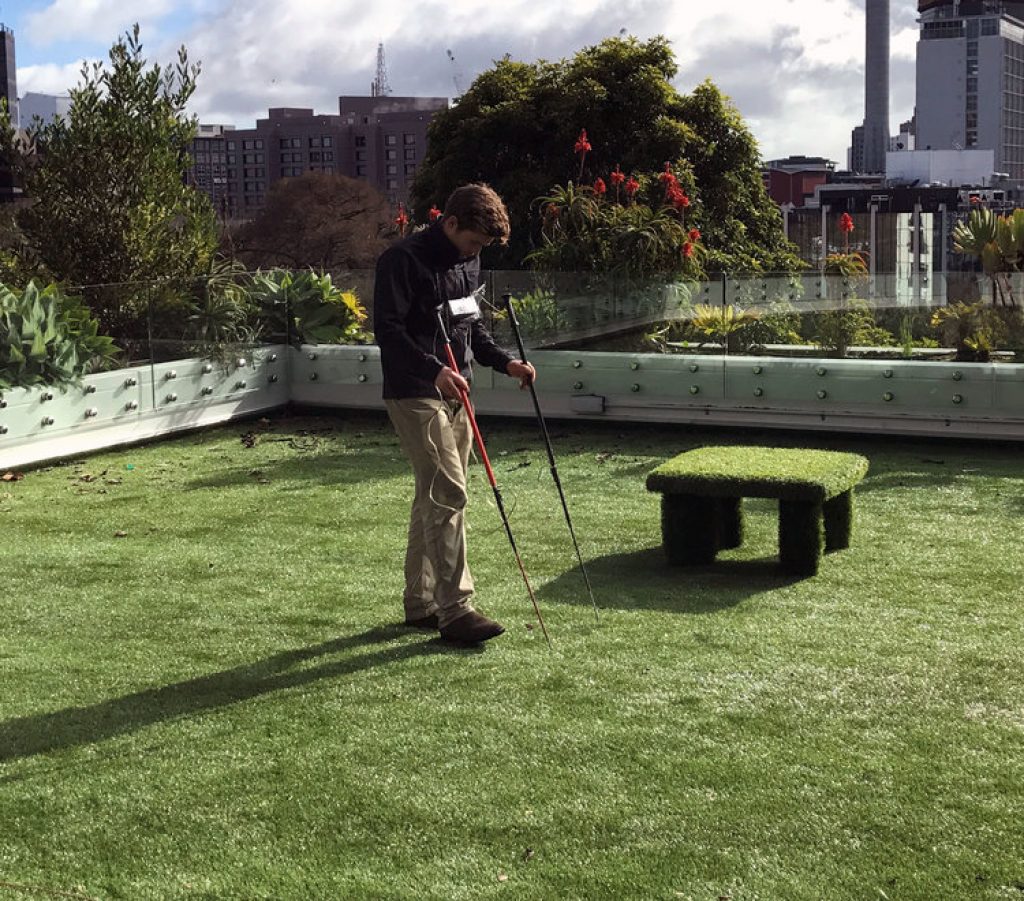
Image source: ILD
Here are some examples of leak detection methods that’ll help you determine if there’s an issue with your roof:
- Flood Test
- Flowing Test
- Electric Field Vector Mapping
- Capacitance Testing
- Infrared Thermography
- Nuclear Meter
- Moisture Sensors
As you can see, there are a number of detection methods available to you if you’re concerned about the presence of a leak.
It’s advisable that you make use of both these methods and professional help should you have any concerns.
Can Green Roofs Survive In Winter?
Absolutely! In fact, green roofs are capable of providing you and society at large with a number of benefits throughout the wintertime.
We did mention these earlier, but if you’ve forgotten, think storm-water management and thermal benefits – both of which come in handy during rough, cold winters.
Best Plants To Use On A Green Roof?
What’s your local climate like? Which plants are readily available to you? Do you have an intensive, semi-intensive, or extensive green roof system?
All of these questions go a long way towards figuring out the best plants to use on a green roof, specifically, your green roof.
But let’s have a look at some examples for an intensive/semi-intensive and extensive green roof system.
Intensive/Semi-Intensive
These roofs will have grasses, ground covers, flowers, shrubs, and even trees.
Examples
Extensive
Extensive systems are more limiting in terms of the plant variety. This is mainly due to their thickness. For this type of system, you’ll want to look into mosses, grasses, wildflowers, grasses, and succulents.
Examples
Final Thoughts
There are more people on this planet than ever before. The more of us there are, the more space we require. The more space we require, the more we encroach on natural vegetation and the habitat of animals.
We owe it to this planet and everything that lives on it to give back, and what better way to start doing that than by bringing the natural world back to our urbanized jungles through green roofs.

